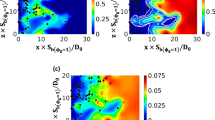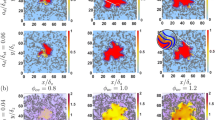Abstract
Three-dimensional Direct Numerical Simulations (DNS) in canonical configuration have been employed to study the combustion of mono-disperse droplet-mist under turbulent flow conditions. A parametric study has been performed for a range of values of droplet equivalence ratio ϕd, droplet diameter ad and root-mean-square value of turbulent velocity u′. The fuel is supplied entirely in liquid phase such that the evaporation of the droplets gives rise to gaseous fuel which then facilitates flame propagation into the droplet-mist. The combustion process in gaseous phase takes place predominantly in fuel-lean mode even for ϕd>1. The probability of finding fuel-lean mixture increases with increasing initial droplet diameter because of slower evaporation of larger droplets. The chemical reaction is found to take place under both premixed and non-premixed modes of combustion: the premixed mode ocurring mainly under fuel-lean conditions and the non-premixed mode under stoichiometric or fuel-rich conditions. The prevalence of premixed combustion was seen to decrease with increasing droplet size. Furthermore, droplet-fuelled turbulent flames have been found to be thicker than the corresponding turbulent stoichiometric premixed flames and this thickening increases with increasing droplet diameter. The flame thickening in droplet cases has been explained in terms of normal strain rate induced by fluid motion and due to flame normal propagation arising from different components of displacement speed. The statistical behaviours of the effective normal strain rate and flame stretching have been analysed in detail and detailed physical explanations have been provided for the observed behaviour. It has been found that the droplet cases show higher probability of finding positive effective normal strain rate (i.e. combined contribution of fluid motion and flame propagation), and negative values of stretch rate than in the stoichiometric premixed flame under similar flow conditions, which are responsible for higher flame thickness and smaller flame area generation in droplet cases.
Article PDF
Similar content being viewed by others
Avoid common mistakes on your manuscript.
References
Heywood, J.B.: Internal Combustion Engine Fundamentals, 1st edn. McGraw Hills (1998)
Aggarwal, S.K.: A review of spray ignition phenomena: present status and future research. Prog. Energy Combust. Sci. 24, 565–600 (1998)
Lefebvre, A.H.: Gas Turbine Combustion, 2nd edn. Taylor & Francis, Ann Arbor, Michigan, USA (1998)
Bowen, P.: Combustion hazards posed by hybrid fuel systems. Proceedings 5th European Combustionis Meeting, Cardiff, UK (2011)
Burgoyne, J.H., Cohen, L.: The effect of drop size on flame propagation in liquid aerosols. Proc. Roy. Soc. Lond. A 225, 375–392 (1954)
Szekely, Jr., G.A., Faeth, G.M.: Effects of envelope flames on drop gasification rates in turbulent diffusion flames. Combust. Flame 49, 255–259 (1983)
Faeth, G.M.: Mixing, transport and combustion sprays. Prog. Energy Combust. Sci. 13, 293–345 (1987)
Ballal, D.R., Lefebvre, A.H.: Flame propagation in heterogeneous mixtures of fuel droplets, fuel vapour and air. Proc. Combust. Inst. 18, 312–328 (1981)
Hayashi, S., Kumagai, S., Sakai, T.: Propagation velocity and structure of flames in droplet-vapor-air mixtures. Combust. Sci. Technol. 15, 169–177 (1976)
Silverman, I., Greenberg, J.B., Tambour, Y.: Stoichiometry and polydisperse effects in premixed spray flames. Combust. Flame 93, 97–118 (1993)
Nomura, H., Koyama, M., Miyamoto, H., Ujiie, Y., Sato, J., Kono, M., Yoda, S.: Microgravity experiments of flame propagation in ethanol droplet-vapor-air mixture. Proc. Combust. Inst. 28, 999–1005 (2000)
Aggarwal, S.K., Sirignano, W.A.: Unsteady spray flame propagation in a closed volume. Combust. Flame 62, 69–84 (1985)
Lawes, M., Saat, A.: Burning rates of turbulent iso-octane aerosol mixtures in spherical flame explosions. Proc. Combust. Inst. 33, 2047–2054 (2011)
Neophytou, A., Mastorakos, E.: Simulations of laminar flame propagation in droplet mists. Combust. Flame 156, 1627–1640 (2009)
Nakamura, M., Akamatsu, F., Kurose, R., Katsuki, M.: Combustion mechanism of liquid fuel spray in a gaseous flame. Phys. Fluids 17, 123301-123314 (2005)
Watanabe, H., Kurose, R., Hwang, S. -M., Akamatsu, F.: Characteristics of flamelets in spray flames formed in a laminar counterflow. Combust. Flame 148, 234–248 (2007)
Watanabe, H., Kurose, R., Komori, S., Pitsch, H.: Effects of radiation on spray flame characteristics and soot formation. Combust. Flame 152, 2–13 (2008)
Fujita, A., Watanabe, H., Kurose, R., Komori, S.: Two-dimensional direct numerical simulation of spray flames – Part 1: Effects of equivalence ratio, fuel droplet size and radiation, and validity of flamelet model. Fuel 104, 515–525 (2013)
Wacks, D.H., Chakraborty, N., Mastorakos, E.: Statistical analysis of turbulent flame-droplet interaction: A Direct Numerical Simulation Study. Flow Turb. Combustion, 10.1007/s10494-015-9652-y (2015)
Miller, R.S., Bellan, J.: Direct numerical simulation of a confined three-dimensional gas mixing layer with one evaporating hydrocarbon-droplet-laden stream. J. Fluid Mech. 384, 293– 338 (1999)
Reveillon, J., Vervisch, L.: Spray vaporization in non-premixed turbulent combustion modelling: a single droplet model. Combust. Flame 121, 75–90 (2000)
Wang, Y., Rutland, C.J.: Direct numerical simulation of ignition in turbulent n-heptane liquid-fuel spray jets. Combust. Flame 149, 353–365 (2007)
Reveillon, J., Demoulin, F.X.: Evaporating droplets in turbulent reacting flows. Proc. Combust. Inst. 31, 2319–2326 (2007)
Sreedhara, S., Huh, K.Y.: Conditional statistics of nonreacting and reacting sprays in turbulent flows by direct numerical simulation. Proc. Combust. Inst. 31, 2335–2342 (2007)
Wandel, A., Chakraborty, N., Mastorakos, E.: Direct Numerical Simulation of turbulent flame expansion in fine sprays. Proc. Combust. Inst. 32, 2283–2290 (2009)
Xia, J., Luo, K.H.: Direct Numerical Simulation of inert droplet effects on scalar dissipation rate in turbulent reacting and non-reacting shear layers. Flow. Turb. Combust. 84, 397–422 (2010)
Neophytou, A., Mastorakos, E., Cant, R.S.: DNS Of spark ignition and edge flame propagation in turbulent droplet-laden mixing layers. Combust. Flame 157, 1071–1087 (2010)
Luo, K., Pitsch, H., Pai, M.G., Desjardins, O.: Direct numerical simulations and analysis of three-dimensional n-heptane spray flames in a model swirl combustor. Proc. Combust. Inst. 33, 2143–2152 (2011)
Wandel, A.: Influence of scalar dissipation on flame success in turbulent sprays with spark ignition. Combust. Flame 161, 2579–2600 (2014)
Neophytou, A., Mastorakos, E., Cant, R.S.: Complex chemistry simulations of spark ignition in turbulent sprays. Proc. Combust. Inst. 33, 2135–2142 (2011)
Neophytou, A., Mastorakos, E., Cant, R.S.: The internal structure of igniting turbulent sprays as revealed by complex chemistry DNS. Combust. Flame 159, 641–664 (2012)
Tarrazo, E., Sanchez, A., Linan, A., Williams, F.A.: A simple one-step chemistry model for partially premixed hydrocarbon combustion. Combust. Flame 147, 32–38 (2006)
Clift, R, Grace, JR, Weber, M.E.: Bubbles, Drops and Particles. Academic Press, New York (1978)
Bray, K.N.C., Domingo, P., Vervisch, L.: Role of the progress variable in models for partially premixed turbulent combustion. Combust. Flame 431-437, 141 (2005)
Malkeson, S.P., Chakraborty, N.: Statistical analysis of displacement speed in turbulent stratified flames: A Direct Numerical Simulation study. Combust. Sci. Technol. 182, 1841–1883 (2010)
Candel, S.M., Poinsot, T.J.: Flame stretch and the balance equation for the flame area. Combust. Sci. Technol. 70, 1–15 (1990)
Chakraborty, N., Cant, R.S.: Effects of strain rate and curvature on Surface Density Function transport in turbulent premixed flames in the thin reaction zones regime. Phys. Fluids 17, 65108 (2005)
Dopazo, C., Cifuentes, L., Martin, J., Jimenez, C.: Strain rates normal to approaching iso-scalar surfaces in a turbulent premixed flame. Combustion Flame, doi:10.1016/j.combustflame.2014.11.034 (2014)
Jenkins, K.W., Cant, R.S.: DNS of turbulent flame kernels. In: Knight, D., Sakell, L. (eds.) Proceedings Second AFOSR Conference on DNS and LES, pp 192–202. Rutgers University, Kluwer Academic Publishers (1999)
Wray, A.A.: Minimal Storage Time Advancement Schemes for Spectral Methods, Unpublished Report. NASA Ames Research Center, California (1990)
Poinsot, T.J., Lele, S.: Boundary conditions for direct simulations of compressible viscous flows. J. Comput. Phys. 101, 104–129 (1992)
Rotexo-Softpredict-Cosilab, GmbH and Co. KG Bad Zwischenahn, Germany
Rogallo, R.S.: Numerical Experiments in Homogeneous Turbulence NASA Technical Memorandum, vol. 81315. NASA Ames Research Center, California (1981)
Grout, R.W.: An age-extended progress variable for conditioning reaction rates. Phys Fluids 105107, 19 (2007)
Han, I., Huh, K.H.: Roles of displacement speed on evolution of flame surface density for different turbulent intensities and Lewis numbers in turbulent premixed combustion. Combust. Flame 152, 194–205 (2008)
Reddy, H., Abraham, J.: Two-Dimensional Direct numerical simulation evaluation of the flame surface density model for flames developing from an ignition kernel in lean Methane/Air mixtures under engine conditions. Phys. Fluids 105108, 24 (2012)
Pera, C., Chevillard, S., Reveillon, J.: Effects of residual burnt gas heterogeneity on early flame propagation and on cyclic variability in spark-ignited engines. Combust. Flame 160, 1020–1032 (2013)
Peters, N.: Turbulent Combustion, Cambridge Monograph on Mechanics. Cambridge University Press, Cambridge (2000)
Yamashita, H., Shimada, M., Takeno, T.: A numerical study on flame stability at the transition point of jet diffusion flames. Proc. Combust. Inst. 26, 27–34 (1996)
Chakraborty, N, Swaminathan, N.: Influence of the Damköhler number on turbulence-scalar interaction in premixed flames. I. Phys. Insight. Phys. Fluids 19, 045103 (2007)
Hartung, G., Hult, J., Kaminski, C.F., Rogerson, J.W., Swaminathan, N.: Effect of heat release on turbulence and scalar-turbulence interaction in premixed combustion. Phys. fluids 20, 035110 (2008)
Chakraborty, N., Klein, M., Swaminathan, N.: Effects of Lewis number on reactive scalar gradient alignment with local strain rate in turbulent premixed flames. Proc. Combust. Inst. 32, 1409–1417 (2009)
Author information
Authors and Affiliations
Corresponding author
Rights and permissions
Open Access This article is distributed under the terms of the Creative Commons Attribution 4.0 International License (http://creativecommons.org/licenses/by/4.0/), which permits unrestricted use, distribution, and reproduction in any medium, provided you give appropriate credit to the original author(s) and the source, provide a link to the Creative Commons license, and indicate if changes were made.
About this article
Cite this article
Wacks, D.H., Chakraborty, N. Flame Structure and Propagation in Turbulent Flame-Droplet Interaction: A Direct Numerical Simulation Analysis. Flow Turbulence Combust 96, 1053–1081 (2016). https://doi.org/10.1007/s10494-016-9724-7
Received:
Accepted:
Published:
Issue Date:
DOI: https://doi.org/10.1007/s10494-016-9724-7




